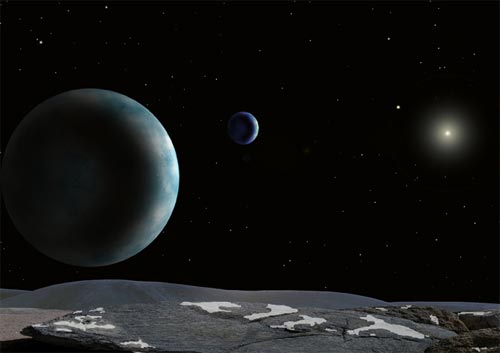Key Takeaways:
In 2 weeks, NASA’s New Horizons spacecraft begins its journey to Pluto and the Kuiper Belt. As the first mission to this region prepares to reveal secrets of the far reaches of our solar system, Earth-based research has shed light on the Pluto-Charon system.
Using a collection of eight microwave telescopes known as the Submillimeter Array (SMA) atop Mauna Kea in Hawaii, astronomers have taken the first direct heat measurements from Pluto and Charon. Mark Gurwell of the Harvard-Smithsonian Center for Astrophysics, coauthor of this study, describes this process as “taking something’s temperature from almost 3 billion miles away without making a house call.”
This measurement revealed that Pluto is colder than expected and chillier than Charon. The SMA data found Pluto’s ice-covered surface is –382° Fahrenheit (43 kelvins), while Charon measured –364° F (53 kelvins).
Gurwell believes this discrepancy is due to Pluto’s surface being composed primarily of nitrogen ice while Charon’s is mainly water ice. The small amount of sunlight reaching the planet converts nitrogen ice to gas but doesn’t heat the surface. There isn’t enough solar energy to melt the moon’s water ice.
“The atmosphere, although thin, creates a buffer,” Gurwell told Astronomy. “Energy vaporizing the nitrogen-ice surface makes for a colder temperature in what I call an ‘anti-greenhouse effect.'”
Understanding the surface differences between Pluto and Charon may provide insight on the bodies’ origins.
Australian amateur astronomer Dave Herald predicted Charon would occult magnitude 15 star UCAC2 26257135 in 2004. An international team of astronomers used telescopes in South American to measure the size of Charon during this event.
Charon, the largest satellite compared to the host planet’ size, is about half the size of Pluto and about eight times less massive. The new observations put Charon’s diameter at 750–753 miles (1,207–1,212 kilometers) and indicate Charon lacks an atmosphere.
The astronomers also determined the satellite’s density is 1.71 times that of water. This suggests its icy contents are just more than 50-percent rock and approximately 10-percent less rock by mass than Pluto. This disparity, according to Amanda Gulbis, lead author of one of the Charon-related papers published in the January 5, 2006, Nature, supports a theory akin to the Earth-Moon system formation.
“This difference suggests that either, or both, objects involved in a Charon-forming collision had concentrations of heavier materials in their cores,” explains Gulbis.










